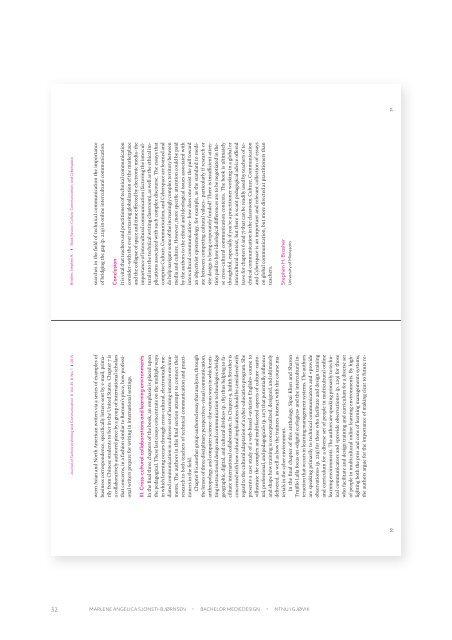Bachelor – Mediedesign NTNU Gjøvik
Min bachelor i mediedesign ved NTNU Gjøvik.
Min bachelor i mediedesign ved NTNU Gjøvik.
Create successful ePaper yourself
Turn your PDF publications into a flip-book with our unique Google optimized e-Paper software.
30<br />
Journal of Technical Writing and Communication Vol. 45 No. 1 2015<br />
ween Asian and North American writers via a series of examples of<br />
business correspondence, specifically letters sent by e-mail, primarily<br />
from Chinese students to her in the United States. Chapter 7 is<br />
a collaboratively authored piece by a group of international scholars<br />
that concerns, in a fashion similar to Barnum’s piece, how professional<br />
writers prepare for writing in international settings.<br />
III. Cross-cultural collaborations and learning environments<br />
In the final three chapters of the book, an emphasis is placed upon<br />
the pedagogical. These last essays concentrate on the multiple ways<br />
in which learning occurs through cross-cultural, electronically mediated<br />
communication in a diverse set of learning-intensive environments.<br />
The authors in this final section attempt to connect their<br />
research to both teachers of technical communication and practitioners<br />
in the field.<br />
Chapter 8 is another group-authored essay that analyzes, through<br />
the lenses of three disciplinary perspectives<strong>–</strong>visual communication,<br />
anthropology, and computer science<strong>–</strong>the various ways in which existing<br />
instructional design and communication technologies «bridge<br />
geographic, digital, and cultural divides» (p. 185) thus helping to facilitate<br />
international collaboration. In Chapter 9, Judith Strother is<br />
concerned with how cultural implications should be considered with<br />
regard to the cultural adaptation of a cyber-education program. She<br />
presents a case study of a web-based «aviation English» course to<br />
«illustrate the complex and multifaceted aspects of culture<strong>–</strong>national,<br />
professional, and pedagogical» (p. 207) that potentially influence<br />
and shape how training is conceptualized, designed, and ultimately<br />
delivered, as well as how the trainees interact with the course materials<br />
in the cyber environment.<br />
In the final chapter of this anthology, Sipai Klien and Sharon<br />
Trujillo Lalla focus on «digital ecologies» and the intercultural interaction<br />
that occurs in learning management systems. The authors<br />
are speaking primarily to technical communicators and «provide<br />
observations» (p. 229) for those who facilitate and design training<br />
and curriculum for a diverse set of people in multicultural online<br />
learning environments. The authors are speaking primarily to technical<br />
communicators and «provide observations» (p. 229) for those<br />
who facilitate and design training and curriculum for a diverse set<br />
of people in multicultural online learning environments. By highlighting<br />
both the pros and cons of learning managements systems,<br />
the authors argue for the importance of making clear to future re-<br />
Brasher, Stephen H. Book Review: Culture, Communication, and Cyberspace<br />
searches in the field of technical communication the importance<br />
of bridging the gap (p. 229) in online intercultural communication.<br />
Conclusion<br />
It is vital that teachers and practitioners of technical communication<br />
consider<strong>–</strong>with the ever increasing globalization of the marketplace<br />
and the collapse of space and time effected by electronic media<strong>–</strong>the<br />
importance of intercultural communication (factoring the intercultural<br />
into the technical writing classroom), as well as the ethical implications<br />
associated with such complex discourse. The essays that<br />
comprise Culture, Communication, and Cyberspace are learned and<br />
do help navigate some of the increasingly complex territory between<br />
media and culture. However, more specific attention could be paid<br />
by the authors to the ethical and ideological issues associated with<br />
intercultural communication<strong>–</strong> how does one resist the pull toward<br />
an objectivist epistemology, for example, as the standard to mediate<br />
between competing cultural values<strong>–</strong> particularly if research or<br />
site design is being corporately funded? There is insufficient attention<br />
paid to how ideological differences are to be negotiated in these<br />
cross-cultural communication contexts. The book is ultimately<br />
thoughtful, especially if you’re a practitioner working in a global or<br />
intercultural context, but there is scant pedagogical advice offered<br />
(save for chapters 6 and 7) that can be readily used by teachers of technical<br />
communication in the classroom. Culture, Communication<br />
and Cyberspace is an important and relevant collection of essays<br />
on global communication, but more directed at practitioners than<br />
teachers.<br />
Stephen H. Brasher<br />
University of Minnesota<br />
31<br />
32 MARLENE ANGELICA SJONSTI-BJØRNSEN BACHELOR MEDIEDESIGN <strong>NTNU</strong> I GJØVIK


